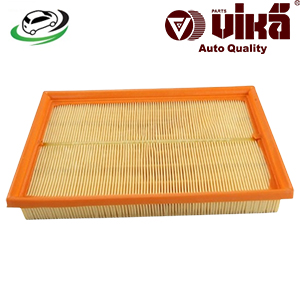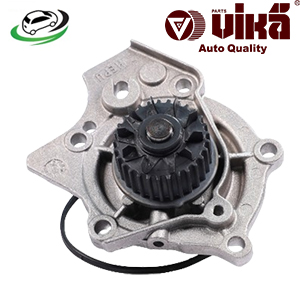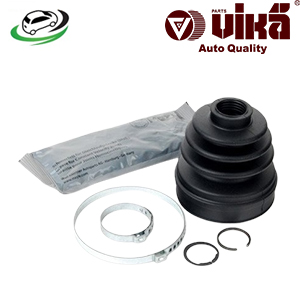-16%
Get Inner Driveshaft Boot Kit VW GOLF II/II/V/Passat 3C2/3C5/Touran IT1/1T2/1T3 / AUDI A3 8PA 1K0498201C
A driveshaft boot kit, also known as a CV (constant velocity) boot kit, is designed to protect the CV joint, which is a crucial part of the driveshaft. The driveshaft is responsible for transferring power from the transmission to the wheels, enabling the vehicle to move. The CV joint allows the driveshaft to flex and articulate, accommodating the up and down movement of the suspension and the steering motion. The boot covers the CV joint, preventing dirt, debris, water, and other contaminants from entering and damaging the joint. Additionally, it helps retain the necessary lubrication inside the joint, ensuring smooth operation.
Components of a Driveshaft Boot Kit
A typical driveshaft boot kit includes the following components:
- CV Boot: The flexible, rubber or thermoplastic cover that encases the CV joint.
- Grease: Lubricant specifically designed for CV joints to reduce friction and wear.
- Clamps: Metal bands or clips used to secure the boot in place at both ends.
- Retaining Rings: Used in some designs to secure the boot to the driveshaft or CV joint.
- Installation Instructions: Detailed guidelines for properly installing the boot kit.
Types of Driveshaft Boots
There are primarily two types of CV boots based on their design and application:
- Outer CV Boots: Located at the outer end of the driveshaft, connecting to the wheel hub. They endure more movement and stress due to steering and suspension articulation.
- Inner CV Boots: Located at the inner end of the driveshaft, connecting to the transmission or differential. They experience less movement but still require protection and lubrication.
Additionally, CV boots can be classified based on their material:
- Rubber Boots: Traditional material offering flexibility and durability but can degrade over time due to exposure to heat, oil, and contaminants.
- Thermoplastic Boots: More resistant to temperature variations, chemicals, and wear, providing longer-lasting protection.
Benefits of a Driveshaft Boot Kit
1. Protection from Contaminants
Prevention of Dirt and Debris Entry
The primary function of a driveshaft boot is to shield the CV joint from contaminants such as dirt, dust, and debris. These particles can cause abrasion and damage to the joint, leading to premature wear.
Water Resistance
Driveshaft boots are designed to be watertight, preventing water from entering the joint. Water can cause rust and corrosion, which can severely damage the CV joint and other drivetrain components.
Chemical Resistance
High-quality driveshaft boots are resistant to chemicals like oil and road salt, which can degrade the material and lead to failure. This resistance ensures that the boot remains intact and effective in protecting the CV joint.
2. Lubrication Retention
Grease Containment
A driveshaft boot kit ensures that the grease inside the CV joint remains contained. Proper lubrication is crucial for reducing friction between the moving parts of the joint, which helps in preventing excessive wear and tear.
Consistent Performance
By maintaining the correct level of lubrication, the driveshaft boot ensures that the CV joint operates smoothly, providing consistent performance and avoiding the jerky movements that can occur with insufficient lubrication.
3. Extended Component Life
Reduced Wear and Tear
The protection provided by the driveshaft boot kit significantly reduces wear and tear on the CV joint and other connected components. This reduction in wear extends the overall lifespan of the drivetrain components.
Cost Savings
By preventing premature failure of the CV joint, a driveshaft boot kit can save vehicle owners considerable amounts of money in repairs or replacements. The cost of a new CV joint or driveshaft is often much higher than the cost of a boot kit.
4. Enhanced Vehicle Performance
Smooth Operation
With the CV joint properly protected and lubricated, the driveshaft can function more smoothly, ensuring that power is efficiently transferred from the transmission to the wheels. This leads to better acceleration and overall vehicle performance.
Improved Handling
A well-maintained CV joint contributes to better handling and steering response. This improvement is particularly noticeable in front-wheel and all-wheel-drive vehicles, where the CV joints are subjected to more movement and stress.
5. Noise Reduction
Elimination of Clicking and Clunking Noises
A damaged or worn CV joint often produces clicking or clunking noises, especially during turns. A driveshaft boot kit helps prevent such damage, thereby reducing or eliminating these annoying sounds and providing a quieter driving experience.
6. Safety Benefits
Preventing Joint Failure
By keeping the CV joint in good condition, a driveshaft boot kit reduces the risk of joint failure. A failed CV joint can lead to a loss of vehicle control, especially at high speeds, posing a significant safety hazard.
Consistent Steering and Handling
Properly functioning CV joints contribute to consistent and predictable steering and handling, which are essential for safe driving, particularly in challenging driving conditions.
7. Ease of Maintenance
Simplified Repairs
Using a driveshaft boot kit simplifies maintenance and repairs. If a boot is damaged, it can be replaced without needing to replace the entire CV joint, making repairs quicker and more cost-effective.
DIY Friendly
Many driveshaft boot kits come with detailed installation instructions, making it possible for vehicle owners with basic mechanical skills to perform the replacement themselves. This ease of installation can save on labor costs.
8. Versatility and Compatibility
Wide Range of Applications
Driveshaft boot kits are available for a wide range of vehicle makes and models, ensuring compatibility with different types of drivetrains, whether front-wheel drive, all-wheel drive, or rear-wheel drive.
Installation of a Driveshaft Boot Kit
Installing a driveshaft boot kit involves several steps, typically requiring basic mechanical skills and tools. Here’s a general outline of the process:
- Lift the Vehicle: Secure the vehicle on jack stands and remove the wheel to access the driveshaft and CV joint.
- Remove the Old Boot: Cut or pry off the clamps securing the old boot, and carefully slide it off the CV joint.
- Clean the CV Joint: Thoroughly clean the CV joint, removing old grease, dirt, and debris.
- Apply New Grease: Pack the CV joint with the new grease provided in the kit.
- Install the New Boot: Slide the new boot onto the driveshaft and position it over the CV joint.
- Secure the Boot: Use the provided clamps to secure the boot in place, ensuring a tight fit at both ends.
- Reassemble the Vehicle: Reinstall the wheel and lower the vehicle, ensuring everything is properly tightened and aligned.
Maintenance of a Driveshaft Boot Kit
Regular maintenance of the driveshaft boot kit is crucial to ensure its longevity and effectiveness. Here are some maintenance tips:
- Regular Inspections: Periodically check the condition of the boots for cracks, tears, or signs of wear.
- Prompt Repairs: Replace damaged boots immediately to prevent contamination and damage to the CV joint.
- Cleanliness: Keep the area around the driveshaft and CV joint clean to minimize the risk of contaminants entering the boot.
- Lubrication: Ensure the CV joint is adequately lubricated, adding grease if necessary during inspections or maintenance.
Common Issues with Driveshaft Boots
- Tears and Cracks: Over time, the material of the boot can degrade, leading to tears or cracks that allow contaminants to enter.
- Loose Clamps: Clamps may become loose or damaged, causing the boot to lose its secure fit and allowing grease to leak out.
- Contamination: Dirt, water, and other contaminants can enter a damaged boot, leading to accelerated wear and potential failure of the CV joint.
- Grease Leakage: A damaged or improperly installed boot can cause grease to leak out, reducing lubrication and increasing friction and wear.
Follow us on Facebook for more parts.



